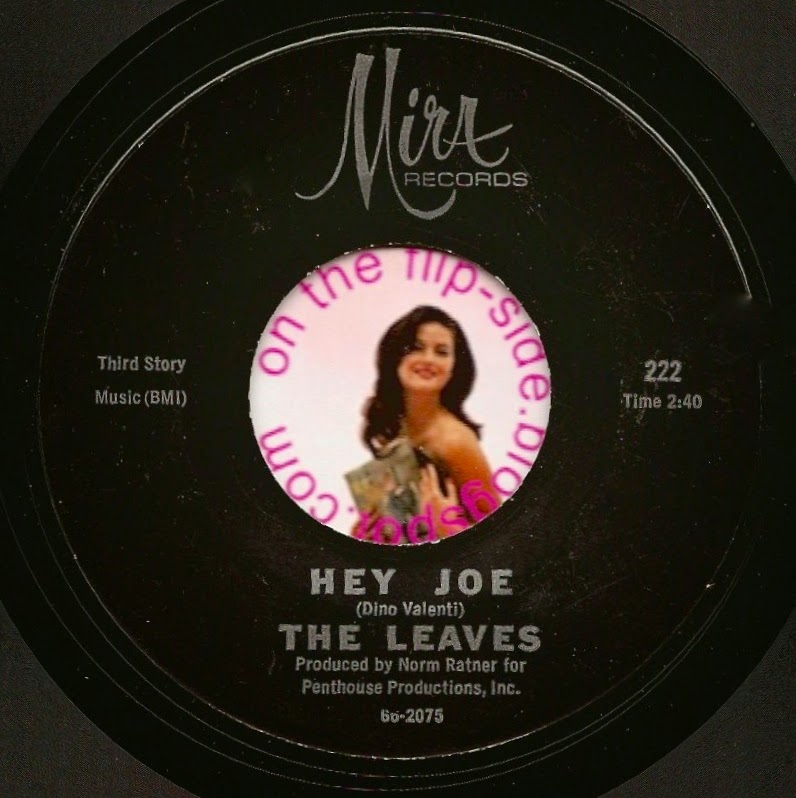First Version
Second Version
Third Version
The Leaves allegedly picked up the Billy Roberts composed folk song, Hey Joe, Where You Gonna Go?, from seeing the two titans of Sunset Strip, The Byrds and Love perform the song. The Leaves smelled a hit and rushed to the studio to record the number before either The Byrds or Love could do so. Sometime in the early Autumn of 1965, Jim Pons, Robert Lee Reiner, John Beck, Bill Rinehart and Tom Ray recorded the number.
Mira Records issued that recording as a White Label Promo with the catalogue number 207 in November of 1965. This first release was a loose, fast-paced attack on the song. The sound quality is iffy at best. The drums smash away with high hats ringing endlessly. At about the 2:19 point Jim Pons' and John Beck's vocals become so off-sync that one of them reverts to laughter. The recording feels like the quick, live-in-studio take that it apparently was. Quite frankly, it is amazing it ever got pressed. The single was never released to the record stores as someone, somewhere rightly deemed this unfit for public release.
The band then went back into the studio and recorded a second version of Hey Joe, Where Are You Gonna Go?. A cleaner approach, this version is most obviously distinguished by periodic whistles throughout the song. John Beck's and Jim Pons' vocals are far more clear and the performance is more steady. This was released to the public as a stock copy (still with catalogue number 207) sometime in very early 1966. Note that neither the first while label promo version or the stock black label version of Hey Joe, Where You Gonna Go? cites a composer of the song. Both versions have the Pons-Rinehart composed Be With You as the Flip-Side. Rinheart's name misspelled on both versions.
About this time, guitarist Bill Rinehart split from the band. Maybe he was pissed that his name was misspelled. The Leaves brought in guitarist Bobby Arlin and rearranged the song replete with a fuzz lead guitar laying down the ascending guitar riff that is now a trademark of the song and a distinctive IV-I-IV-II-V bridge (at the 1:21 mark). The band went into the studio and re-recorded the song and Mira Records released the number for the third time in April, 1966 with catalogue number 222 first as a white label promo and then, two weeks later, as a stock copy. This version took off and reached number 31 on the Billboard charts. The song title was shortened to the radio friendly Hey Joe and writing credit was wrongly given to Dino Valenti. The Flip-Side of the Mira Records #222 release was the Bobby Arlin composed, Funny Little World. To further confuse the matter, Mira Records then ran a second pressing of the record with a red label and a different Flip-Side of Girl From The East. In between, they released a totally different Leaves single (Funny Little World/Girl From The East) with the same friggin' catalogue number! Clear as mud, right?
Until next time, we'll see you On The Flip-Side!





Very cool! Have to say that descending guitar lead is just essential to the song, but all three takes are great in their own way. Does anyone else incorporate that bridge from the third version?
ReplyDeletethe guitar lead is ascending, not descending. Just sayin'. It is really key to making the song have a clear riff. Obviously incorporated by many different acts, not the least of which is Jimi Hendrix.
DeleteAs for the bridge, I can think of another band that used it. Thus clearly learning the song from The Leaves. Maybe I'll post that one tonight or tomorrow. The bridge is so good. It really breaks up the potential monotony in the song.
I'm talking about the high lead that comes in at :12 on version three and absent in the others - brilliant, and descending. The other riff which is bass driven is ascending and descending. Just sayin'. Looking forward to the next post.
DeleteOh, got it. Yes that guitar riff is descending and is cool as a witches' tit. The other one, which is indeed largely bass, was the one of which I thought you were speaking.
DeleteVintage Garage Band's signature song in Houston, TX in 2013 timeframe!
ReplyDelete